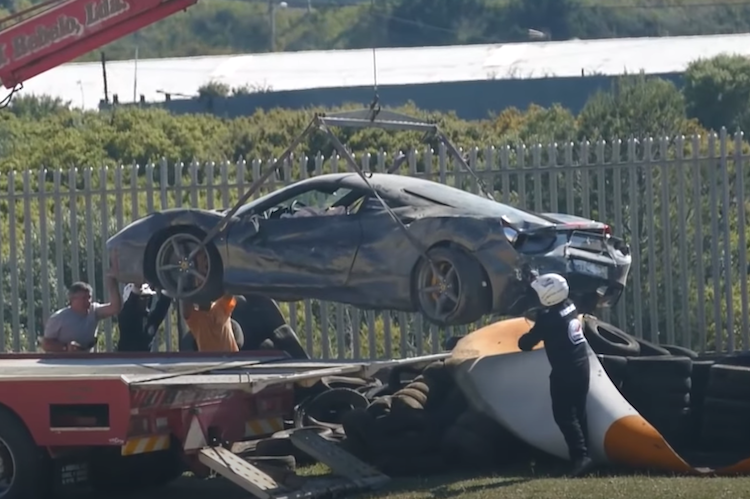“In line with uncompromising engineering practices,” Ferrari’s Recall Information web page asserts, “Ferrari operates according to stringent standards to maintain levels of safety and performance on its vehicles.” Given that Ferrari’s recalling every vehicle manufactured from 2005 to the present day for potentially catastrophic Ferrari brake failure, their boast about “uncompromising engineering practices” and “stringent standards” is both oddly-placed and patently vainglorious. More ammunition for Porsche owners’ condescension? Hang on a sec . . .

On September 21 of last year, Volkswagen of America and Porsche Cars North America recalled a range of 2020 – 21 VW and Porsche models for a potential brake booster defect. A quick reminder of the booster’s role in keeping a vehicle from plowing into solid objects.
The brake booster is in line between the brake pedal and brake master cylinder. It essentially amplifies the force applied to the pedal by your foot and outputs more braking force in the hydraulic braking system. This makes braking your vehicle a much less physical task.
When a brake booster is failing you may notice that braking effort increases. the engine runs poorly or stalls with force on the brake pedal, or the relative resting position of the brake pedal has changed. In these cases it is recommended to inspect the hoses leading to the brake booster as well as the brake booster itself. If the brake booster is in fact faulty it is highly recommended to replace it as soon as possible.
fcopeuro.com
Replacing a bad booster ASAP is “highly recommended” because “a hard pedal with no braking power” is a bad day in the making. Not to put too fine a point on it, when a brake booster fails, the brakes fail.
Here’s the National Highway Traffic Safety Administration’s Part 573 Safety Recall Reports (21V-695 and 21V-697) description of the VAG Group’s brake booster defect.
On the affected vehicles, there is a possibility that the screw connection of the pressure input rod of the brake booster was not carried out according to the specifications . . . if the pressure input rod becomes detached, the brake pedal becomes ineffective, increasing the risk of a crash.

We don’t know for sure that the Ferrari brake failure is down to bad brake boosters. By Ferrari’s own admission, it’s a strong suspect.
On October 29, 2021, Ferrari filed a Part 573 Safety Recall Report (21V-833) covering 2010 – 2015 Ferrari 458’s and “some” 2016 – 2019 Ferrari 488’s. Under “description of cause,” Ferrari states “Unknown at this time. Ferrari and the supplier of the brake booster/pump assembly, Bosch, are continuing to investigate this issue.”
So if Ferrari suspected that a defective Bosch brake booster was the culprit in numerous examples of sudden Ferrari brake failure, and VAG recalled their 911’s and Taycan’s (and other vehicles) to fix the Bosch booster, why didn’t Ferrari recall all cars similarly equipped?

“The Ferrari 458 and 488 model vehicles are no longer in production,” Ferrari’s Part 573 filing avers, “and subsequent Ferrari models do not use the same brake master cylinder/ brake booster component.” And yet the forthcoming Ferrari recall covers all cars from 2005 to present, including models made after the 488.
Last year, Ferrari admitted that it “is not yet aware of the root cause of this problem, nor the number of vehicles actually affected by it.” Since then, Ferrari decided a non-venting brake reservoir cap was to blame for customers’ catastrophic brake failure.
VAG had a different take. Porsche replaced all the brake boosters in all its 2020 – 2021 Porsche 911 Carreras and Taycans. A new Ferrari brake booster costs about $500. Labor runs around $200 an hour. At $1000 per swap, replacing the brake boosters on all 23,555 cars covered by the Ferrari recall would cost $23,555,000.

That’s loose change for an automaker worth $36b. Surely, Ferrari wouldn’t sweep bad brake boosters under the proverbial rug for such a relative pittance? By the same token, shouldn’t all Ferrari/Bosch brake boosters be inspected – if not replaced – when the recalled vehicles come in for a new brake fluid reservoir cap and software update?
Wouldn’t that be the safe thing to do? It’s definitely not the plan. The official “fix” is restricted to swapping the vehicles’ non-porous brake fluid reservoir cap (below) with a porous one and tweaking the software. [See: Ferrari – Unsafe at Any Speed]

It’s actually a lot worse than a missed opportunity. Here’s the fact that Ferrari doesn’t want anyone to know: the “swap the cap” fix doesn’t work. At least it didn’t in one case.
A freshly-serviced late model Ferrari equipped with a venting brake fluid reservoir cap and new software lost its brakes and slammed into a racetrack barrier (a different incident from the one above).
A representative of the NHTSA will be inspecting the totalled car next week. (I’ll be there and report back.) If the NHTSA isn’t satisfied with Ferrari’s fix, they could issue a “red letter recall” signifying that all cars within the recall’s scope should not be driven until the problem can be fixed. In effect, grounding 23,555 Ferraris.
What is the problem? Ferrari’s catastrophic brake failure isn’t necessarily either/or. It’s possible that the original brake reservoir cap is a danger and Bosch brake boosters are breaking. Oh, and there’s another potential Ferrari brake system defect, which I’ll detail in the next post.



As Einstein may, or may not, have said,“The definition of insanity is doing the same thing over and over again and expecting different results.”
Einstein’s first words may or may not have been “this soup is too hot.” I reckon he’d understand why this journalist is kvetching about Ferrari.